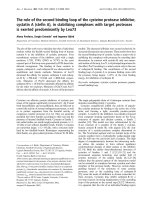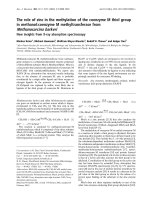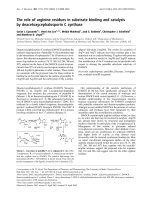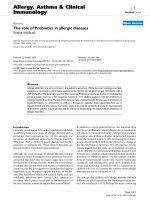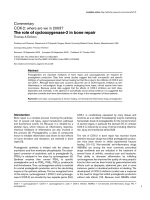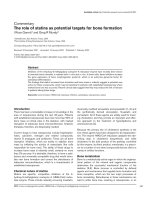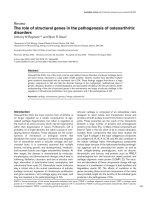Báo cáo Y học: The role of arginine residues in substrate binding and catalysis by deacetoxycephalosporin C synthase potx
Bạn đang xem bản rút gọn của tài liệu. Xem và tải ngay bản đầy đủ của tài liệu tại đây (159.94 KB, 5 trang )
The role of arginine residues in substrate binding and catalysis
by deacetoxycephalosporin C synthase
Sarah J. Lipscomb
1,
*, Hwei-Jen Lee
1,2,
*, Mridul Mukherji
1
, Jack E. Baldwin
1
, Christopher J. Schofield
1
and Matthew D. Lloyd
1,3
1
Oxford Centre for Molecular Sciences and the Dyson Perrins Laboratory, Oxford, UK;
2
Department of Biochemistry,
National Defence Medical Centre, Taipei, Taiwan;
3
Department of Pharmacy and Pharmacology, The University of Bath, UK
Deacetoxycephalosporin C synthase (DAOCS) catalyses the
oxidative ring expansion of penicillin N, the committed step
in the biosynthesis of cephamycin C by Streptomyces clavu-
ligerus. Site-directed mutagenesis was used to investigate the
seven Arg residues for activity (74, 75, 160, 162, 266, 306 and
307), selected on the basis of the DAOCS crystal structure.
Greater than 95% of activity was lost upon mutation of Arg-
160 and Arg266 to glutamine or other residues. These results
are consistent with the proposed roles for these residues in
binding the carboxylate linked to the nucleus of penicillin N
(Arg160 and Arg162) and the carboxylate of the a-amino-
adipoyl side-chain (Arg266). The results for mutation of
Arg74 and Arg75 indicate that these residues play a less
important role in catalysis/binding. Together with previous
work, the mutation results for Arg306 and Arg307 indicate
that modification of the C-terminus may be profitable with
respect to altering the penicillin side-chain selectivity of
DAOCS.
Keywords: cephalosporin; penicillin; b-lactam; 2-oxogluta-
rate; nonhaem iron(II) oxygenase.
Deacetoxycephalosporin C synthase (DAOCS; Swissprot
P18548) is an iron(II) and 2-oxoglutarate-dependent
oxygenase that catalyses the conversion of penicillin N
(Scheme 1, 1) to deacetoxycephalosporin C (DAOC 2)in
Streptomyces clavuligerus [1–7]. The subsequent hydroxyla-
tion of DAOC to give deacetylcephalosporin C (DAC 3)is
catalysed by a closely related oxygenase, deacetylcephalo-
sporin C synthase (DACS; Swissprot P42220). The DAC 3
product is then converted into cephamycin C 4 in a process
involving oxidation at the C-7 position (Scheme 1).
Our understanding of the catalytic mechanism of
DAOCS [8–10] has been significantly advanced by the
determination of the crystal structure of wild-type and
mutant DAOCS with various ligands [1,11–13]. However, a
detailed understanding of the ring-expansion reaction
requires structural information for DAOCS complexed
with penicillin substrates and deacetoxycephem products.
Attempts to cocrystallise DAOCS in the presence of various
substrates and products have been hampered by their
instability under the crystallization conditions.
DAOCS contains eight arginine residues within, or close
to, its active site that may be involved in catalysis. Arg258
has already been shown by structural and mutagenesis
studies to bind the 5-carboxylate of the 2-oxoglutarate [13].
Mutagenesis of this residue to glutamine reduced
2-oxoglutarate conversion. However, other aliphatic 2-oxo-
acids, which are not cosubstrates for wild-type DAOCS,
had higher levels of activity as they interact more
favourably with the mutated cosubstrate binding site. Here
we report site-directed mutagenesis studies on the other
arginine residues located within the active site (74, 75, 160,
162, 266, 306 and 307) that, together with the crystallo-
graphic analyses, support the proposed roles for arginines
160, 162 and 266, and suggest roles for the other arginine
residues.
Scheme 1. Conversion of penicillin N (1) to cephamycin C (4). 2-OG,
2-oxoglutarate; R,
D
-d-(a-aminoadipoyl)-; *, methyl group incorpor-
ated into cephem ring by DAOCS. The putative high-energy iron
intermediate [Fe(IV) ¼ O/Fe(III)-O.] is shown boxed. Note that the
precise arrangement of the ligands around the iron is uncertain [12].
Correspondence to M. D. Lloyd, The Department of Pharmacy and Pharmacology, The University of Bath, Claverton Down,
Bath BA2 7AY, UK. Fax: + 44 1225 386114, E-mail:
Abbreviations: DAC, deacetylcephalosporin C; DACS, deacetylcephalosporin C synthase; DAOC, deacetoxycephalosporin C; DAOCS,
deacetoxycephalosporin C synthase; Dnase 1, deoxyribonuclease 1; EDTA, ethylenediaminetetraacetic acid; ESI MS, electrospray ionization
mass spectrometry; USE, unique site elimination.
*Note: these authors contributed equally to this work.
(Received 4 January 2002, revised 12 April 2002, accepted 19 April 2002)
Eur. J. Biochem. 269, 2735–2739 (2002) Ó FEBS 2002 doi:10.1046/j.1432-1033.2002.02945.x
EXPERIMENTAL PROCEDURES
Materials
All chemicals were obtained from the Sigma–Aldrich
Chemical Co. or Merck and were of analytical grade or
higher. Reagents were also supplied by: Amersham
Biosciences (protein chromatography systems and columns,
U.S.E. Mutagenesis Kit); Bohringer–Mannheim (ATP);
MBI (1 Kb and 100 bp DNA gel markers); Bio-Rad
(Kunkel mutagenesis reagents); New England Bio-Labs
(enzymes for molecular biology); Novagen (pET vectors);
Sigma-Genosys (mutagenesis primers); Phenomenex
(HPLC columns); Promega (Wizard Plus miniprep DNA
purification system, Wizard Plus SV miniprep DNA
purification system); Stratagene (competent cells, PCR
Script vector, QuikChange mutagenesis kit).
Site-directed mutagenesis
The R162Q and R162A mutants were constructed using
the Stratagene QuikChange system, with the DAOCS
gene subcloned into the PCR-Script vector. Primers
(0.1 nmol) (Table 1) were made in complementary pairs
andextendedinthe5¢ to 3¢ direction. The R160Q,
R306L and R307Q mutants were constructed by the
Kunkel method [14,15]. The remaining mutants were
constructed using the unique site elimination (USE)
system [16]. Automated DNA sequencing (Department of
Biochemistry, University of Oxford, UK) before sub-
cloning into the pET11a or pET24a vectors confirmed
the sequences of all mutants. The required plasmids were
transformed into Escherichia coli XL1 Blue and E. coli
BL21 (DE3) and expressed and grown as previously
reported [1].
Purification and assay of DAOCS mutants
Wild-type DAOCS and the Arg160 and 162 mutants were
purified to 85% homogeneity (by SDS/PAGE analysis)
from 25 g of frozen recombinant E. coli cells by anion-
exchange and gel filtration chromatographies as previously
described [1]. The Q-sepharose column was eluted with an
80–320 m
M
NaCl gradient over 800 mL. The required
fractions were pooled, concentrated to 8 mL and further
purified using a Superdex-200 column (86 · 3.2 cm,
692 mL) equilibrated in gel filtration buffer [1].
The remaining mutants were purified on a smaller scale to
85% homogeneity (by SDS/PAGE analysis) using the
following protocol. Frozen recombinant E. coli cells (1.5–
3.5 g) were resuspended in 50 m
M
Tris/HCl, 1 m
M
EDTA,
pH 7.5 and 2 m
M
dithiothreitol (20 mL) and treated with
lysozyme (6 mg). The sample was stirred for 10 min before
addition of MgCl
2
(5 m
M
)andDnase1(20lg). After a
further 10 min stirring, the sample was sonicated (4 · 20 s)
and centrifuged at 24 000 g for 20 min The supernatant was
filtered through a 0.22-lm filter and loaded onto a HiPrep
Q-Sepharose (16/10) XL column pre-equilibrated with the
above buffer at 5 mLÆmin
)1
. Protein was eluted using a
120–400 m
M
NaCl gradient over 80 mL. Fractions (5 mL)
containing DAOCS were pooled and (NH
4
)
2
SO
4
solution
added to a final concentration of 1.2
M
.Thesamplewas
filtered, loaded onto a RESOURCE-PHE column equili-
brated with the above buffer and 1.2
M
(NH
4
)
2
SO
4
at
3mLÆmin
)1
, and protein eluted with a 0.96–0.36
M
(NH
4
)
2
SO
4
gradient over 120 mL. Fractions (5 mL) were
analysed by SDS/PAGE following trichloroacetic acid
precipitation. Purified protein was exchanged into 50 m
M
Tris/HCl pH 7.5 using an Econo-Pak column (Bio-Rad)
and concentrated to 15 mgÆmL
)1
. Purified mutants were
analysed by circular dichroism analysis as previously
described [1]. Highly purified wild-type enzyme and mutants
were also analysed by ESI MS [wild-type: 34 551 Da
(predicted), 34 550 ± 9 Da (observed); R160Q: 34 525 Da
(predicted), 34 524 ± 7 Da (observed); R162Q: 34 525 Da
(predicted), 34 525 ± 9 Da (observed)].
Activity assays
Radioactive 2-oxoglutarate conversion assays were conduc-
ted as previously described [17], using 0.1 m
M
penicillin N,
10 m
M
penicillin G or water as substrates. Assays based on
the detection of deacetoxycephem products used the repor-
ted HPLC system [1]. Assay mixtures containing penicil-
lin G were purified by HPLC with a Hypersil C4 column
(250 · 4.6 mm) using 5 mL of 25 m
M
NH
4
HCO
3
in 15%
(v/v) methanol at 1 mLÆmin
)1
, followed by a gradient to
25 m
M
NH
4
HCO
3
in 80% (v/v) methanol over 20 mL.
Table 1. Primers used to construct DAOCS mutants. Bold residues denote the mutation site. USE, unique site elimination. Selection primers:
(pstI–ncoI) 5¢-CGTGACACCACGATGC*CATGGGCAATGGCAACAACG-3¢;(ncoI–pstI) 5¢-CGTGACACCACGATGCCTGCA*GCAA
TGGCAACAACG-3¢. *denotes cleavage site for selection primers. PCR, Stratagene QuikChange Mutagenesis Kit. Kunkel, Method developed by
Kunkel [14,15].
Mutation Primer sequence Method
R74I 5¢-CCCGTCCCCACCATGATCCGCGGCTTCACCGGG-3¢ USE
R74Q 5¢-CCCGTCCCCACCATGCAGCGCGGCTTCACCGGG-3¢ USE
R75I 5¢-CCCGTCCCCACCATGCGCATCGGCTTCACCGGG-3¢ USE
R75Q 5¢-CCCGTCCCCACCATGCGCCAGGGCTTCACCGGG-3¢ USE
R160Q 5¢-TAGCGGAACTGCAGCAGCG-3¢ Kunkel
R162A 5¢-CGCTGCTGCGGTTCGCATACTTCCCGCAGGTC-3¢ PCR
R162Q 5¢-CGCTGCTGCGGTTCCAATACTTCCCGCAGGTC-3¢ PCR
R266I 5¢-AGTGTGTTCTTCCTCATCCCCAACGCGGACTTC-3¢ USE
R266Q 5¢-AGTGTGTTCTTCCTCCAGCCCAACGCGGACTTC-3¢ USE
R306L 5¢-GATGTGCGCAGGATGTTCA-3¢ Kunkel
R307Q 5¢-CTTGGATGTCTGGCGGATGTT-3¢ Kunkel
2736 S. J. Lipscomb et al. (Eur. J. Biochem. 269) Ó FEBS 2002
Retention volumes for product and substrate were 18.3 and
19.5 mL, respectively. Approximately 0.15 mg of enzyme
wasusedineach100lL assay.
1
H NMR (500 MHz)
spectroscopy was used to confirm the presence of the
expected cephem products [1]. Note the radioactive and
HPLC assays are carried out under different conditions.
RESULTS
Construction and purification of mutants
The following single mutants were constructed by site-
directed mutagenesis: R74I, R74Q, R75Q, R160Q, R162Q,
R162A, R266I, R266Q, R306L and R307Q. The following
double mutants were constructed using a second round of
mutagenesis: R74I/R266I, R74Q/R266I, R74I/R266Q and
R74Q/R266Q. Sequencing of the clones revealed that only
the desired mutations were present except in the R75I
mutant, which also contained an additional mutation,
D270G. Analysis of the DAOCS structure [1,11,12],
indicated that this mutation would be on the surface of
the protein. All mutants and wild-type enzyme were
purified to 85% purity (by SDS/PAGE analyses) using
anion-exchange and gel filtration or anion–exchange and
hydrophobic interaction chromatographies. Circular di-
chroism analyses of the mutants suggested that no gross
changes in structure had occurred compared to the wild-
type enzyme.
Enzyme assays
Wild-type DAOCS and all mutants were assayed for their
ability to convert 2-oxoglutarate to succinate and carbon
dioxide [17], and penicillin N and penicillin G to their
corresponding deacetoxycephem products [1,18] (Table 2).
The levels of 2-oxoglutarate conversion were corrected for
the rate observed in the absence of a penicillin substrate, i.e.
these results represent stimulation of 2-oxoglutarate con-
version. Steady-state kinetic analyses were carried out on
wild-type enzyme and those mutants catalysing significant
penicillin oxidation.
Arginines 74, 75 and 266
In the case of the R74I, R74Q and R75Q mutants (Table 2,
entries 2, 3 and 5), 2-oxoglutarate conversion was signifi-
cantly stimulated by the presence of penicillin N (> 25%,
the level of wild-type DAOCS), indicating that substrate
binding occurs. The slightly lower levels of penicillin N
oxidation compared to 2-oxoglutarate conversion may be
indicative of partial uncoupling of the two reactions. More
detailed kinetic analyses of penicillin N conversion by the
arginine 74 and 75 mutants (Table 3) showed that k
cat
and
K
m
values were similar to the values for the wild-type enzyme.
2-Oxoglutarate conversion by the R74I and R74Q
mutants was also significantly stimulated by the presence
of penicillin G (Table 2, entries 2 and 3). However, penicillin
G oxidation was considerably reduced relative to the wild-
type enzyme, i.e. it was less than stoichiometric for
2-oxoglutarate conversion. The results for the R75Q mutant
in the presence of penicillin G showed little or no evidence
for 2-oxoglutarate stimulation or penicillin G oxidation,
suggesting that this mutation had abolished or severely
affected ÔprimeÕ substrate binding. The low levels of
penicillin G oxidation by the R74I, R74Q and R75Q
mutants prevented further kinetic analysis of these mutants
with this substrate.
When Arg266 was mutated (R266L, R266Q) (Table 2,
entries 13–14) 2-oxoglutarate conversion was very low and
the same whether penicillin N, penicillin G or no penicillin
Table 3. Kinetic parameters. Top, kinetic parameters for penicillin N
conversion (10–50 lm) by wild-type DAOCS and arginine mutants by
HPLC assay. Parameters were determined [1] at 2 mm 2-oxoglutarate
using at least five different concentrations of penicillin substrate, at
least in duplicate. Values are reported ± SD. Bottom, kinetic
parameters for penicillin G conversion (0.5–3.0 mm) of wild-type
DAOCS and arginine mutants by HPLC assay. Parameters were
determined [1] at 2 mm 2-oxoglutarate using at least five different
concentrations of penicillin substrate, at least in duplicate. Values are
reported ±SD.
Mutant K
m
(m
M
) k
cat
(s
)1
) k
cat
/K
m
(
M
)1
Æs
)1
)
Penicillin N
Wild-type 0.033 ± 0.016 0.020 ± 0.007 606
R74I 0.033 ± 0.007 0.010 ± 0.002 303
R74Q 0.025 ± 0.010 0.006 ± 0.001 240
R75I/D270G 0.086 ± 0.020 0.060 ± 0.010 697
R75Q 0.065 ± 0.040 0.030 ± 0.010 461
R306L 0.056 ± 0.008 0.160 ± 0.027 2857
R307Q 0.027 ± 0.003 0.070 ± 0.004 2592
Penicillin G
Wild-type 0.7 ± 0.1 0.050 ± 0.006 71
R306L 0.6 ± 0.1 0.070 ± 0.003 116
R307Q 7.0 ± 0.7 0.060 ± 0.010 8
Table 2. Activity assay results for wild-type and mutant DAOCS with
penicillin N and penicillin G. Assays for 2-oxoglutarate conversion [17]
are corrected for conversion in the absence of any substrate. HPLC
assays [1] were used to assess penicillin conversion. Results are nor-
malized to penicillin N conversion by wild-type enzyme (26 nmolÆ
min
)1
Æmg
)1
) and are based on at least duplicate readings. Standard
deviations are 15% and 10% for 2-oxoglutarate and penicillin
conversion, respectively. ND, not determined.
DAOCS enzyme
Penicillin N Penicillin G
2-OG HPLC 2-OG HPLC
1. Wild-type 100 100 79 65
2. R74I 100 76 53 6
3. R74Q 209 45 93 5
4. R75I/D270G 83 62 31 42
5. R75Q 45 25 <5 8
6. R74I/R266I <5 <2 <5 <2
7. R74Q/R266I <5 <2 <5 <2
8. R74I/R266Q <5 <2 40 4
9. R74Q/R266Q <5 <2 <5 <2
10. R160Q ND ND <5 4
11. R162Q ND ND <5 3
12. R162A ND ND <5 <2
13. R266I <5 <2 <5 3
14. R266Q <5 <2 <5 3
15. R306L 200 200 41 64
16. R307Q 38 144 26 39
Ó FEBS 2002 Role of arginine residues in DAOCS (Eur. J. Biochem. 269) 2737
substrate was present. Similarly, 2-oxoglutarate conversion
was not stimulated by penicillin substrates in the R74I/
R266I, R74Q/266I or R74Q/R266Q mutants (Table 2,
entries 6–9). These results suggest penicillin binding has
been abolished or severely affected in the arginine-266
mutants.
Arginines 160 and 162
No stimulation of 2-oxoglutarate conversion was observed
in the presence of penicillin G for the R160Q, R162Q and
R162A mutants (Table 2, entries 10–12), consistent with
loss of penicillin binding.
Arginines 306 and 307
The specific activity analyses suggested that mutation of
Arg306 to leucine, and to a lesser extent Arg307 to
glutamine, enhanced penicillin N conversion compared to
the levels of wild-type DAOCS (Table 2, entries 15–16).
However, no enhancement in activity compared to wild-
type levels was observed when penicillin G was used as a
substrate (Table 2, entries 15–16). Steady-state kinetic
analyses (Table 3) showed that k
cat
for penicillin N was
increased for both the R306L and R307Q mutants with
smaller changes in the K
m
value. The R306L mutation had
little effect on kinetic values using penicillin G as substrate
(Table 3), whereas the R307Q mutation increased the K
m
value by 10-fold, but had little effect on the k
cat
value. Note
the increased specific activity for the R306L mutant may
reflect a decreased rate of inactivation for this mutant.
DISCUSSION
The reaction catalysed by the iron(II) and 2-oxoglutarate-
dependent oxygenases involves conversion of 2-oxogluta-
rate and dioxygen to give succinate, carbon dioxide and an
enzyme-bound reactive oxidizing intermediate, believed to
be a high-energy ferryl [Fe(IV) ¼ O/Fe(III)-O.] species
[1,4]. The latter is used to effect the oxidative conversion of
the prime substrate (in the case of DAOCS, the penicillin).
For many 2-oxoglutarate-dependent oxygenases, 2-oxo-
glutarate conversion occurs at a low rate in the absence of
prime substrates but is stimulated by their presence [4,19].
Studies with some oxygenases (e.g. clavaminic acid syn-
thase [20,21]) have suggested that prime substrate binding
activates the enzyme–iron(II)-2-oxoglutarate ternary com-
plex to oxygen binding, thereby initiating catalysis and
ensuring coupling of 2-oxoglutarate conversion to prime
substrate oxidation.
In the case of DAOCS it has been previously shown that
mutations to residues involved in 2-oxoglutarate or penicil-
lin binding [12,13] can result in substantial uncoupling of
penicillin oxidation from 2-oxoglutarate (i.e. there is a less
than stoichiometric oxidation of the penicillin substrate).
Uncoupling of 2-oxoglutarate conversion can also appar-
ently result from mutations to residues not directly involved
in substrate or cosubstrate binding [17]. Stimulation of
2-oxoglutarate conversion is therefore evidence for ÔprimeÕ
substrate binding, but not necessarily of its oxidation.
The effects of the DAOCS arginine mutations reported in
this paper fall into three types. Some mutations prevent or
seriously hinder productive penicillin (prime) substrate
binding to the enzyme (arginines 160, 162 and 266), as
demonstrated by the lack of stimulation of 2-oxoglutarate
conversion and the almost complete absence of any
deacetoxycephem product. Other mutants, e.g. R74Q,
apparently bind the penicillin substrate sufficiently well to
stimulate 2-oxoglutarate conversion, but probably not in
the optimal manner for penicillin oxidation leading to some
Ôuncoupled turnoverÕ. This is clear when penicillin G is used
as substrate, and may be a consequence of the higher K
m
value for this substrate [1,22]. The third type of mutant,
represented by arginines 306 and 307, are located in the
C-terminus. They appear to modulate the activity of the
C-terminus, which encloses the DAOCS active site during
catalysis [12] and prevents premature loss of the penicillin
substrate before oxidation.
Penicillin substrate binding to DAOCS
The results in this paper give support to the proposed
mode of penicillin binding by DAOCS [1,12] a key feature
of which is that arginines 160 and 162 bind to the carbonyl
and/or carboxylate of the bicyclic b-lactam nucleus, with
the pro-S methyl group projecting towards the iron
(Fig. 1). We also propose that Arg266 forms a salt bridge
with the carboxyl group of the a-aminoadipoyl- side-chain
of penicillin N (1), with arginines 74 and 75 apparently
playing a less important role in side-chain binding. Taken
together, the results of this and previous studies [12,13]
suggest that correct orientation of the penicillin substrate
with respect to the putative high-energy ferryl intermediate
is important for optimum coupling between 2-oxoglutarate
and penicillin conversion.
Recent studies have suggested that the C-terminus of
DAOCS (including arginines 306 and 307) is involved in
conformational changes during catalysis. It is possible that
DAOCS and other 2-oxoglutarate dependent oxygenases
have evolved to maximize coupling between 2-oxoglutarate
and ÔprimeÕ substrate oxidation. This is probably required in
order to control the reactive oxidizing species produced
during catalysis and to avoid inactivation of the enzyme.
Evidence for the oxidative inhibition of TfdA under
uncoupled conditions has been reported [23].
Re-engineering of DAOCS to accept hydrophobic peni-
cillin substrates is a desirable objective, as this may allow
fermentation of starting materials for production of semi-
synthetic cephem antibiotics. The results in this paper
suggest that point mutations to C-terminal residues (per-
Fig. 1. Proposed binding mode for penicillin N to the iron(II)-2-oxo-
glutarate complex of DAOCS, showing possible involvement of selected
residues.
2738 S. J. Lipscomb et al. (Eur. J. Biochem. 269) Ó FEBS 2002
haps in conjunction with C-terminal truncation [12] or other
active site mutations [24]) may allow improved conversion
of unnatural substrates (e.g. penicillin G) whilst maintaining
tight coupling between substrate oxidation and 2-oxoglut-
arate conversion.
ACKNOWLEDGEMENTS
We thank Dr R. T. Aplin for mass spectrometric analyses and Mrs E.
McGuinness and Dr B. Odell for NMR analyses. Mrs W. J. Sobey is
thanked for technical assistance. The Biotechnology and Biological
Sciences Research Council, Engineering and Physical Sciences Research
Council, Medical Research Council, the Wellcome Trust and the
European Union are thanked for financial assistance.
REFERENCES
1. Lloyd, M.D., Lee, H J., Harlos, K., Zhang, Z.H., Baldwin,
J.E., Schofield, C.J., Charnock, J.M., Garner, C.D., Hara, T.,
Terwisscha van Scheltinga, A.C. et al. (1999) Studies on the
active site of deacetoxycephalosporin C synthase. J. Mol. Biol.
287, 943–960.
2. Schofield, C.J., Baldwin, J.E., Byford, M.F., Clifton, I.J., Hajdu, J.
& Roach, P.L. (1997) Proteins of the penicillin biosynthesis
pathway. Curr. Opin. Struct. Biol. 7, 857–864.
3. Baldwin, J.E. & Schofield, C.J. (1992) The Chemistry of b-lactams.
Blackie Academic and Professional, London.
4. Prescott, A.G. & Lloyd, M.D. (2000) The iron (II) and 2-oxoacid-
dependent dioxygenases and their role in metabolism. Nat. Prod.
Reports 17, 367–383.
5. Jensen, S.E. (1986) Biosynthesis of cephalosporins. CRC Crit. Rev.
Biotechnol. 3, 277–301.
6. Martin, J.F. (1998) New aspects of genes and enzymes for beta-
lactam antibiotic biosynthesis. Appl. Microbiol. Biotechnol. 50,
1–15.
7. Baldwin, J.E. & Abraham, E. (1988) The biosynthesis of peni-
cillins and cephalosporins. Nat. Prod. Reports 5, 129–145.
8. Townsend, C.A., Theis, A.B., Neese, A.S., Barrabee, E.B. &
Poland, D. (1985) Stereochemical fate of chiral-methyl valine in
the ring expansion of penicillin N to deacetoxycephalosporin C.
J. Am. Chem. Soc. 107, 4760–4767.
9. Pang, C.P., White, R.L., Abraham, E.P., Crout, D.H.G., Lutstorf,
M., Morgan, P.J. & Derome, A.E. (1984) Stereochemistry of the
incorporation of valine methyl groups into methylene groups in
cephalosporin C. Biochem. J. 222, 777–788.
10. Baldwin,J.E.,Adlington,R.M.,Kang,T.W.,Lee,E.&Schofield,
C.J. (1988) The ring expansion of penicillins to cephems: a possible
biomimetic process. Tetrahedron 44, 5953–5957.
11. Valega
˚
rd, K., Terwisscha van Scheltinga, A.C., Lloyd, M.D.,
Hara, T., Ramaswamy, S., Perrakis, A., Thompson, A., Lee, H J.,
Baldwin, J.E., Schofield, C.J., Hajdu, J. & Andersson, I. (1998)
Structure of a cephalosporin synthase. Nature 394, 805–809.
12. Lee, H J., Lloyd, M.D., Harlos, K., Clifton, I.J., Baldwin, J.E. &
Schofield, C.J. (2001) Kinetic and crystallographic studies on
deacetoxycephalosporin C synthase (DAOCS). J. Mol. Biol. 308,
937–948.
13. Lee, H J., Lloyd, M.D., Clifton, I.J., Harlos, K., Dubus, A.,
Baldwin, J.E., Frere, J M. & Schofield, C.J. (2001) Probing the
cosubstrate selectivity of deacetoxycephalosporin C synthase: The
role of arginine-258. J. Biol. Chem. 276, 18290–18295.
14. Kunkel, T.A. (1985) Rapid and efficient site-specific mutagenesis
without phenotypic selection. Proc.NatlAcad.Sci.USA82, 488–
492.
15. Kunkel, T.A., Roberts, J.D. & Zakour, R.A. (1987) Rapid and
efficient site-specific mutagenesis without phenotypic selection.
Methods Enzymol. 154, 367–382.
16. Deng, W.P. & Nickoloff, J.A. (1992) Site-directed mutagenesis of
virtually any plasmid by eliminating a unique site. Anal. Biochem.
200, 81–88.
17. Lee, H J., Lloyd, M.D., Harlos, K. & Schofield, C.J. (2000) The
effect of cysteine mutations on the activity of recombinant
deacetoxycephalosporin C synthase from S. clavuligerus. Biochem.
Biophys. Res. Commun. 267, 445–448.
18. Baldwin, J.E., Adlington, R.M., Coates, J.B., Crabbe, M.J.C.,
Crouch, N.P., Keeping, J.W., Knight, G.C., Schofield, C.J., Ting,
H.H., Vallejo, C.A., Thorniley, M. & Abraham, E.P. (1987)
Purification and initial characterization of an enzyme with dea-
cetoxycephalosporin C synthetase and hydroxylase activities.
Biochem. J. 245, 831–841.
19. Myllyharju, J. & Kivirikko, K.I. (1997) Characterization of the
iron and 2-oxoglutarate-binding sites of prolyl 4-hydroxylase.
EMBO J. 16, 1173–1180.
20. Zhou, J., Gunsior, M., Bachmann, B., Townsend, C.A. & Solo-
man, E.I. (1998) Substrate binding to the a-ketoglutarate-
dependent non-haem iron enzyme clavaminate synthase 2:
Coupling mechanism of oxidative decarboxylation and hydroxy-
lation. J. Am. Chem. Soc. 120, 13539–13540.
21. Zhang, Z H., Ren, J., Stammers, D.K., Baldwin, J.E., Harlos, K.
& Schofield, C.J. (2000) Structural origins of the selectivity of the
trifunctional oxygenase clavaminic acid synthase. Nat. Struct.
Biol. 7, 127–133.
22. Dubus,A.,Lloyd,M.D.,Lee,H J.,Schofield,C.J.,Baldwin,J.E.
& Frere, J M. (2001) Substrate selectivity studies on deacetox-
ycephalosporin C synthase using a direct spectrophotometric
assay. Cell. Mol. Life Sci. 58, 835–843.
23.Liu,A.,Ho,R.Y.N.,Que,L.,Ryle,M.J.,Phinney,B.S.&
Hausinger, R.P. (2001) Alternative reactivity of an alpha-
ketoglutarate-dependent iron (II) oxygenase: enzyme self hydro-
xylation. J. Am. Chem. Soc. 123, 5126–5127.
24. Lee, H J., Schofield, C.J. & Lloyd, M.D. (2002) Active site
mutations of recombinant deacetoxycephalosporin C synthase.
Biochem. Biophys. Res. Commun. 292, 66–70.
Ó FEBS 2002 Role of arginine residues in DAOCS (Eur. J. Biochem. 269) 2739
